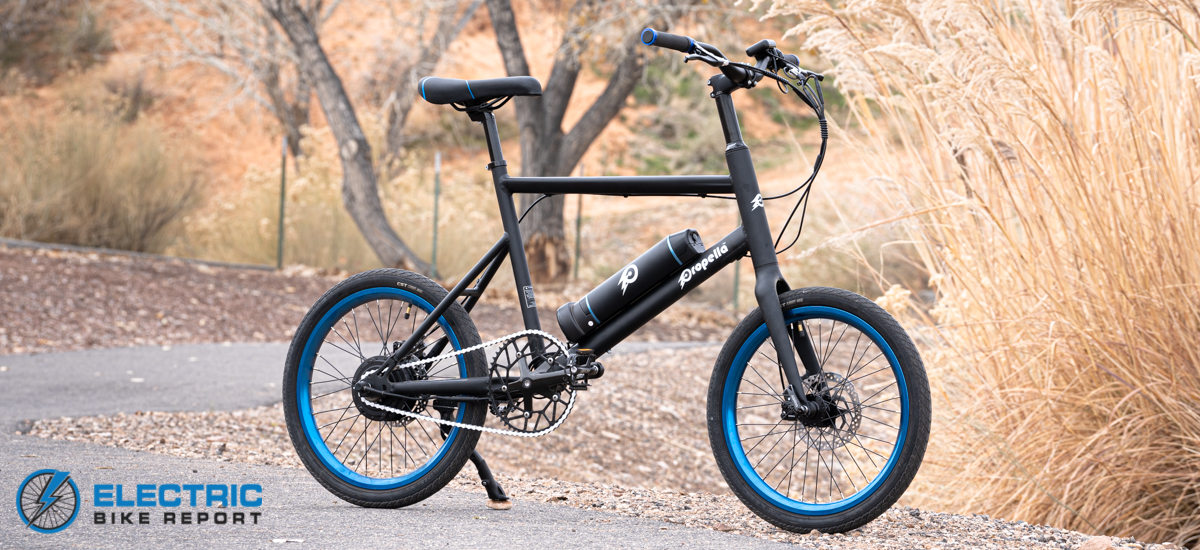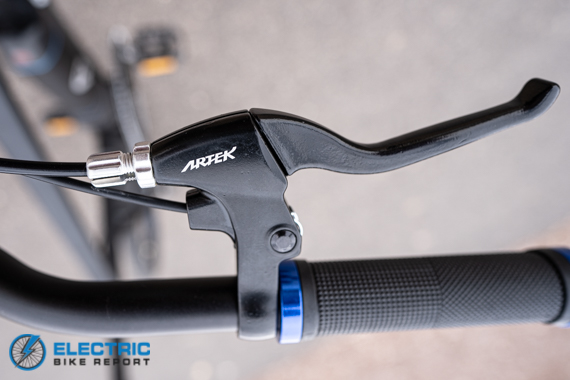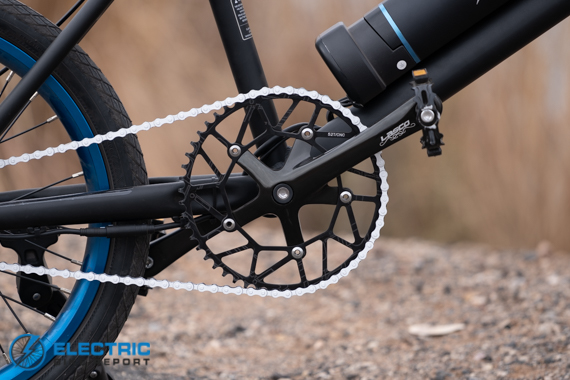Propella Mini Review 2024

The Propella Mini is a rolling reminder that sometimes less is more.
Less can be cheaper; less can be lighter; and sometimes, less can just be more fun. In this Propella Mini review, we dive into this super affordable, super simplistic and super quirky electric bike to see how it performs in the real world.
Powered by a 250W Bafang geared rear hub motor and a 36V, 7Ah (250Wh) battery, the Mini is modestly powered compared to the more typical rear hub-driven e-bikes we see on the market today. But what it lacks in raw power it makes up with its notably low weight of just 33 lbs and its sheer nimbleness — it’s a really, really quick handling e-bike.
To get a sampling of the Mini’s performance, we put the bike through a gauntlet of tests including a range test, hill test, braking test and more so you can have a better idea if it’s the right e-bike for you.
It may be small, but is it mighty? We put it to the test to find out.
 Pro’s
Pro’s- Probably one of the most purely fun e-bikes I’ve ridden. It feels like a BMX bike with an e-bike motor.
- Surprisingly comfortable for such an unorthodox frame design.
- The LCD display is very simple but very effective. It’s easy to read in all types of light.
- The Shimano Tourney TX mechanical disk brakes do a wonderfully good job of controlling speed.
- At first glance it may give clown bike vibes, but its oddball looks have really grown on our reviewing team.
- We’re really big fans of the handling. The small 20-inch wheels make it nimble in corners but the long wheelbase and balanced riding position make it stable at speed.
- The Bafang 250W motor feels appropriately sized. The bike is quick but it doesn’t reach astronomical speeds — a good thing for this one.
 Con’s
Con’s- While the 36V, 7Ah battery helps keep costs low, it does leave the Mini with a shorter range than many other bikes in the sub-$1,000 category.
- The 46t x 16t gear ratio felt good on the hills but left me spinning quite quickly at higher speeds. The Mini might benefit from a taller gear if you live in a flat area.
- Battery: 36V, 7Ah (250Wh) frame-mounted battery
- Display: LCD display
- Motor: Bafang 250W geared rear hub motor
- Headlight: N/A
- Taillights: N/A
- Peal Assist: Five PAS settings, cadence sensor
- Range: 20-35 mile (claimed)
- Throttle: N/A
- Claimed weight: 33 lbs
- Maximum rider weight: 220 lbs
- Maximum load on rear rack: N/A
- Brakes: Shimano TourneyTX calipers, generic levers and 160mm rotors front and rear
- Fenders: N/A
- Fork: Aluminum
- Frame: Aluminum
- Drivetrain: Single speed, 46t x 16t
- Grips: Rubber
- Saddle: Standard generic bicycle seat
- Handlebar: Zoom alloy flat bars
- Kickstand: Included
- Pedals: Alloy
- Tires: CST 20” x 1.75”
Propella Mini Review: Bike Overview
Obviously, the mini is a very small e-bike. It rolls on 20-inch wheels and the frame has almost clown-bikeish proportions. But Propella says this bike is more than just a novelty: It’s small stature and remarkably light 33 lb weight make it appealing to riders short on space, new to e-bikes or maybe even needing to carry their bike up flights of stairs.
Despite its odd visual proportions, the Mini’s frame really isn’t that small. Compared to the more traditional looking Propella SS V4.0 we reviewed a few months ago, the Mini’s dimensions are at most 1-inch shorter in the top tube and seat tube lengths. The frame is designed to fit riders ideally between 5’2” and 5’10”, so while a child could ride this bike its frame dimensions are much closer to that of a full-sized e-bike. I’m 6’1” and I was actually able to ride this thing pretty comfortably.
It’s also intended to be very, very affordable — something Propella accomplished by keeping the bike very simple.
There’s no gears. Instead, it sports a single speed drivetrain with a 46t x16t gear ratio that feels a little spinny at higher speed but balances out by being a pretty good climbing gear. The brakes are a set of base-level Shimano TourneyTX mechanical disk brake calipers mated with 160mm rotors front and rear and a set of generic levers on the handlebars. .
For the electrical bits, Propella gave the Mini a Class 1 250W Bafang geared rear hub motor powered by a 36V, 7Ah (250Wh) frame-mounted battery. That motor is limited to 18 mph and there’s no throttle.
And that’s it — there’s not really a whole lot more to it.

The Propella Mini has an unconventional look that may not suit everyone, but sure grew on us.

A set of generic brake levers actuate the Shimano TourneyTX mechanical disk brake calipers.

The 20-inch CST tires were grippy and efficient.
Propella Mini Review: Motor Performance, Speed and Acceleration
The 250W Bafang motor is a Class 1 unit limited to 18 mph, a few mph below the legal 20 mph mark. That’s pretty typical of these smaller motors. At low speeds, it feels very peppy and accelerates quickly — which is a likely function of these small 20” wheels, which help the bike accelerate quicker.
It’s got five PAS levels, and to get a sampling of these we took the Mini for five laps around our test circuit, plus one with the bike turned entirely off. What we get from these laps is an idea of how the bike feels in each PAS level, how useful the low PAS settings are and, because everyone loves speed, a hot lap around our circuit.
For the PAS usefulness, we found the Mini didn’t really give a measurable amount of assistance until PAS 3. Our average speed in PAS 1 was exactly the same as pedaling the bike with the motor entirely off and PAS 2 was only a marginal improvement over that. You can still ride the Mini in those low PAS levels — it is a fairly nice pedaling e-bike that doesn’t weigh much — but if you want this e-bike to feel like an e-bike we’d recommend sticking to PAS 3 or above.
For the hot lap in PAS 5, we recorded a 16.6 mph average lap around our circuit, which is very close to the bike’s max motor assisted speed of 18 mph — a solid result.

At a glance, the Propella Mini looks very similar to some of the smaller folding e-bikes.

The 250W Bafang geared rear hub motor suits this bike nicely. It’s snappy and has good grunt on hills.

The 36V, 7Ah (250Wh) battery is mounted on the downtube.
Propella Mini Review: Range Test & Battery Performance
With cost efficiency being one of the guiding principles behind the Mini, the 36V, 7Ah battery makes a lot of sense. Batteries are the most expensive component of an e-bike, so by going smaller you’re going to save a good chunk of money.
But with a smaller battery, you’re going to get a smaller range. We did two range tests on the Mini, one in PAS 5 and the other in PAS 3. Our choice to do a test in PAS 5 should be pretty self explanatory: We wanted to see how far it would go using the most assistance, but our choice to use PAS 3 may be a little less obvious. As we mentioned in the circuit test section, PAS 3 was the lowest assist setting that the Mini gave detectable assistance so we chose to range test it in that setting. We theoretically could see a further range in a lower assist setting, but we’d wager few people will want to ride the Mini for a long distance in a lower setting than PAS 3 unless they have to.
In both tests, the Mini performed about as expected. In PAS 5, the bike went for 14.49 miles at an average speed of 15.2 mph while in PAS 3 the bike went for 22.76 miles with an average speed of 12.8 mph.
Compared to the range test results of similarly powered and priced e-bikes we’ve reviewed in the past, the Mini’s range results are a little lower than average. The Ride1UP Roadster V2 we reviewed this year, for example, which is powered by the same size battery as the Mini but with a larger motor, went for over 16 miles on max power. The Rad Power Bikes RadMission, which for the same price boasts a much larger 48V, 10.4Ah battery, went for over 40 miles.
The Mini may not be a long hauler, but I’d argue it very much isn’t intended to be. It’s quirky design alone should be a strong indicator that this bike prioritizes fun over function, and for that purpose I’d say its range suits the Mini fine.
Propella Mini Review: Hill Test & Drivetrain Performance
I have to admit that I had a lot of doubts about how the Propella Mini would perform on our test hill, Hell Hole. With a single speed drivetrain and a very modest 250W motor, I wouldn’t have faulted the bike had the hill got the best of it — bikes far more powerful, better geared and much pricier fail our hill test all the time.
But the Mini did not give out. In fact, it laid down a pretty respectable time.
The Mini crested Hell Hole in 1:36.00 with an average speed of 11.3 mph. Compared to all the bikes we’ve tested on Hell Hole, that time is in the bottom quarter of results. But regardless of where that result is on our leaderboard, we’re incredibly impressed the Mini was able to put up a result at all.
There are several factors that, in hindsight, should have tipped me off that the Mini would do fine on our test hill. The first is the bike’s weight — it’s just 33 lbs. Second is the balanced 46t x 16t gear ratio, which feels soft and spinny at high speeds but actually is a pretty decent climbing gear, even on steep stuff. Lastly I have to give credit to the 250W Bafang geared rear hub motor, which, despite its comparatively low wattage, doles out a solid punch of low-end grunt.
I also should have known better than to doubt the Mini because the Ride1UP Roadster V2 also put up a good time on Hell Hole. That bike has a larger 350W rear hub motor, but it’s similarly a single speed with a gearing that’s much tougher on climbs than the Mini’s ratio.
One thing to note is that, like in our hill test of the Roadster, I had to stand and pedal almost the entirety of Hell Hole’s one-third of a mile length. Had I not stood and climbed a little more athletically, I’m not sure the Mini would have made it.
Athleticism is a theme we saw throughout all our testing on the Mini; it’s a bike that requires some physical input from the rider to perform well.

Standing was mandatory in order to clear our test hill, Hell Hole. But regardless the Mini is an impressive climber for such a small and modestly powered e-bike.

The Shimano TourneyTX mechanical brakes do a surprisingly good job, bringing the bike to a stop in an average distance better than 85 percent of the bikes we’ve reviewed.

The 46t x 16t single speed gearing is a nice balance between high speeds and climbability.
Propella Mini Review: Brakes, Handling and Cockpit
The brakes on the Propella Mini are a mixed set made of Shimano TourneyTX mechanical calipers, generic levers and 160mm rotors front and rear.
These are base-level disk brakes from Shimano that aren’t just affordable, but perform pretty well. Across five full-power stops from 20 mph, the Mini came to a stop at an average distance of 12-feet-7-inches. That’s a really awesome result that’s better than 85 percent of the bikes we’ve reviewed so far.
When tuned properly, mechanical disk brakes are an awesome affordable alternative to hydraulic disk brakes. But they are a very finicky component that I’d highly suggest having set up or at least checked by a professional mechanic.
Handling wise, the Mini rides like a BMX bike. It’s nimble, fast and wants to be ridden aggressively. Much of those handling characteristics are due to the bike’s small 20-inch wheels, which make the Mini more flickable in corners and help it accelerate quicker.
The bike’s cockpit is refreshingly simple, with no shifter or throttle and just one display on the left-hand side. There’s no frills like a color LCD, but that display works very well. It’s easy to read in all light conditions and very intuitive.
Propella Mini Review: Ride Comfort, Geometry and Extras
Though it looks small — almost child-sized — the Propella Mini rides a lot like a full-sized e-bike.
The 5-foot-2-inch to 5-foot-10-inch ideal height envelope is a little short for me, but I was surprised that I didn’t feel more cramped when riding the Mini. Its got an upright riding position and flat, MTB-style handlebars that are comfortable and wide enough to stretch out a little.
The seat is more of a traditional bike seat as opposed to a comfort saddle — which I think suits this bike well — plus comfortable rubber grips. It’s certainly not a bike I’d reach for to take on a long distance ride, but for short trips around town or rides more geared towards fun, the Propella Mini is plenty comfortable.
Aside from the bike’s core components, there’s very little by way of extras. It lacks fenders, lights and racks, though there appears to be mount points for a rear fender or light rack should you want it.

The LCD display is simple but remarkably functional and easy to read.

The saddle is padded with an athletic profile.

Lock on rubber grips for the win.

The stout single speed drivetrain should stand up well in weather and is more simple to maintain.
Propella Mini Review: Summary / Where to Buy
The Propella Mini isn’t going to be the e-bike for everyone, but for those who dig its funky looks I don’t think it’s going to disappoint.
Bikes like this are really great because they are so simple they’re almost hard to mess up. Propella definitely went on a limb here with the looks and design, but I think they managed to pull it off. Some people are going to like it for its low weight; others for the price and others — people like me — are going to like it for its novelty.
I’ve been pleased with the single speed drivetrain, and I’d tell anyone in the market for a good cheap e-bike to not be scared away by the idea of one gear. The only issue I found with this is they chose a small enough gear that I found myself spinning out at high speeds, but conversely I was able to climb more hills than if they’d put a bigger ratio on there — a tradeoff I’ll gladly accept.
And among its competitors in the $1000 or less category, is it a good deal? I think that’s subjective, but I’d say the only metric the Mini may fall short in is its battery life. There are similarly priced e-bikes we’ve reviewed that do go further, but range is not all that matters.
Rather than battery life or power, the Propella Mini places a premium on fun. In that category, I think it does a really good job. All in all, I’ve been pleasantly surprised by the Mini. It’s a solid bike for a solid price — an oddball that’s grown on me the more time I’ve spent with it.
You can buy the Propella Mini online on Propella’s website and have it shipped to your door. It’s fairly simple to assemble, but should you need help I’d highly suggest taking it to your local bike shop for assembly or a final safety check before riding.
‘Happy Riding, make sure to let us know if you have any questions down in our comments section or if you think we left anything out in this review of the Propella Mini




I got a Montague Boston 2015 and fitted a GBOOST on , works nicely and after 4 previous ebikes, no one can’t avoid it , light is right , and that’s the great improvement every day-today user is waiting,
Good choice from Propela , with this mini they point out that a bike even an ebike , has to give you fun and pleasure, not only power and easy pedalling.